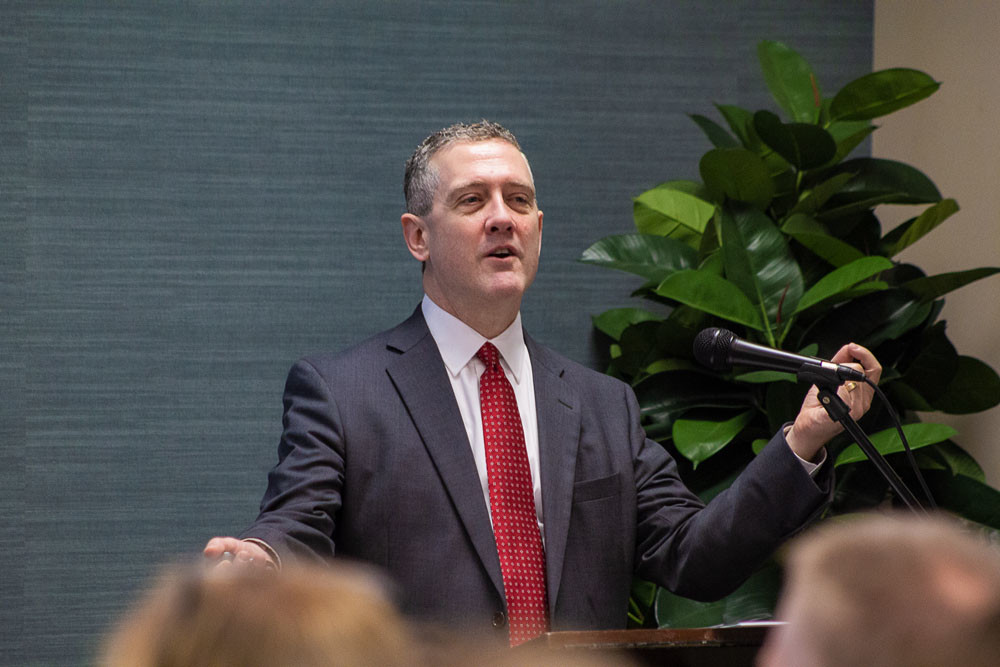YOUR BUSINESS AUTHORITY
Springfield, MO
YOUR BUSINESS AUTHORITY
Springfield, MO

The president of the Federal Reserve Bank of St. Louis is cautioning against federal policy rate increases forecast during June and September.
As president and CEO, James Bullard oversees the St. Louis Fed as part of the Eighth Federal Reserve District, a subset of the Federal Reserve Central Bank that comprises all of Arkansas and portions of Missouri, Mississippi, Tennessee, Kentucky and Indiana.
Bullard serves on the Free Open Market Committee. He recently dropped by Springfield for a two-day visit, and presented a “case for caution” on U.S. monetary policy during a May 11 meeting of the Springfield Business Development Corp.
The current Fed policy rate rests between 1.5 percent and 1.75 percent. The rate has increased five times since 2016, from a relatively steady 0.4 percent lasting nearly a year prior, according to Bullard’s presentation.
Increased Fed rates generally spur higher borrowing costs for consumers and businesses – also making it harder for some to access lines of credit. The Fed’s intent is to combat inflation and stimulate the economy.
Known to have a dissenting opinion, Bullard highlighted five cautionary points against the overall quarter-point rate increase expected this year.
1. Low inflation
Bullard said market-based inflation expectations remain below the Free Open Market Committee’s targeted 2 percent.
He said U.S. financial markets do not see inflation pressure and do not expect the Fed to hit its 2 percent target, even during the next five years.
Short-term rate increases, Bullard said, subsequently are unnecessary to keep U.S. inflation in check, and a steady rate would re-establish inflation expectations at the target.
2. Neutral policy rate
A neutral policy rate setting currently puts neither upward nor downward pressure on inflation, which indicates rate changes also are not needed to check inflation, Bullard said.
“The economy is actually performing quite well right now,” he said, noting unemployment sits below 4 percent and mean inflation rests at about 1.8 percent.
“So you’ve got low inflation and low unemployment all at the same time,” Bullard said. “We should probably be opening the champagne here.”
3. Flat yield curve
The spread between one-year and 10-year U.S. Treasury yields, aka the yield curve, has been flattening since 2014, Bullard said.
At that time, the spread was close to 300 points, and as of the first week of May it sat at 72 basis points.
If the yield curve inverts, or when short-term yields shift to outpace long-term yields, economic troubles could be looming. An inverted yield curve historically served as an accurate marker of economic recession.
Bullard said increased Fed rates could trigger an inversion this year or early next year.
“It’s possible that this nominal yield curve will invert sometime in the next year,” he said, noting after his presentation that a second rate increase in September would make an inversion more likely. “That’s why I’m concerned about it.”
4. Business investments
Bullard said business investments – as a fraction of the gross domestic product – have been “disappointingly low” since the 2008 financial crisis and have room still to grow.
He said federal tax reform enacted this year, if ultimately successful, could strengthen the growth without causing inflationary side effects.
The Fed ultimately should wait to see whether post-reform success surfaces, Bullard said.
“If corporate tax reform is successful today and over the next two or three years, then I would expect to see more investment and, hopefully, more productivity in the U.S economy than what we would have otherwise,” he said.
5. Labor markets
Current unemployment conditions, such as Springfield’s March jobless rate of 3.2 percent, indicates a hard-fought equilibrium of U.S. labor markets, Bullard said.
“We had labor markets that were badly dislocated by many ventures during the 2007-2009 recession,” he said. “It has taken years and years to repair that in the U.S. economy.”
Disrupting the equilibrium via rate increases to control inflation is unnecessary, Bullard said.
Local perspectives
Springfield Area Chamber of Commerce President and CEO Matt Morrow said he agreed with Bullard.
“He knows what he’s talking about,” Morrow said, adding the presentation “offers a good opportunity to hear his perspective – and he’s here listening, too, not just talking.”
Brad Crain, president and CEO of Arvest Bank – one of the largest regional lenders with total assets of more than $18 billion – held a more reserved viewpoint after the presentation.
Crain pointed to increasing price pressures on businesses and consumers via inflation, despite the national rate hovering below the Fed’s 2 percent target.
“Consumers are starting to feel the impact of inflation,” Crain said, acknowledging Bullard’s points make sense from a macroeconomic perspective.
He said, however, businesses are complaining about higher costs of raw materials and transportation. Households, meanwhile, are being negatively impacted by greater energy costs from increased oil and gas prices, Crain said.
“Inflation, while it’s not above the 2 percent mark that the Fed tries to maintain, it is impacting the markets, and it is impacting consumers,” he said. “The Fed, their necessary response is going to be they have to move rates.
“As I see it, the market has already priced in two additional rate hikes this year,” Crain said, “so high interest rates are coming.”
Guest columnist Donnie Brawner says many entrepreneurs stray from their original business ventures, which is often a recipe for success.